france
new! Cathedrale Saint-Gatien at Tours 
 updated: Romanesque churches and cathedrals in south-west France updated: Romanesque churches and cathedrals in south-west France
the perpendicular or English style of cathedral 
the fire at the cathedral of Notre-Dame de Paris

cathedral giants - Amiens and Beauvais
Stone tracery in church and
cathedral construction 
stone in church and cathedral construction stained glass and cathedrals in Normandy  
fortified churches, mostly in Les Landes
cathedral labyrinths and mazes in France
using metal in gothic cathedral construction
Germans in France
cathedral destruction during the French revolution, subsidiary page to Germans in France

on first arriving in France - driving
France is not England
paying at the péage (toll station)

Transbordeur bridges in France and the world 2: focus on Portugalete, Chicago,
Rochefort-Martrou
Gustave Eiffel’s first work: the Eiffel passerelle, Bordeaux
a fifth bridge coming to Bordeaux: pont Chaban-Delmas, a new vertical lift bridge
France’s western isles: Ile de Ré
France’s western iles: Ile d’Oleron
Ile de France, Paris: in the context of Abelard and of French cathedrals
short biography of Pierre (Peter) Abelard
Marianne - a French national symbol, with French definitive stamps
la Belle Epoque
Grand Palais, Paris


Pic du Midi - observing stars clearly, A64
Carcassonne, A61: world heritage fortified city
Futuroscope
Vulcania
Space City, Toulouse
the French umbrella & Aurillac
50 years old:
Citroën DS
the Citroën 2CV:
a French motoring icon
the forest as seen by Francois Mauriac, and today
Les Landes, places and playtime
roundabout art of Les Landes
Hermès scarves

bastide towns
mardi gras! carnival in Basque country
country life in France: the poultry fair
what a hair cut! m & french pop/rock

Le Tour de France: cycling tactics 

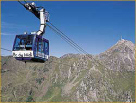
|
pic du midi aire
pic du midi observatory
a short history of the
Pic du Midi Observatory
the
importance of this observatory
the
telescopes and other instruments
the
pic du midi observatory - some interesting facts
space
sketch map locating the pic
du midi aire
end
notes Motorway aires are designed to provide a suitable
environment for relaxing, refreshing and recovering during the
long, hard journeys. As well as facilities of often dubious nature,
picnic tables and seats, a telephone kiosk, there are often optional
extras such as a play area or a display related to some local
interest or event. 
the
Pic du Midi aire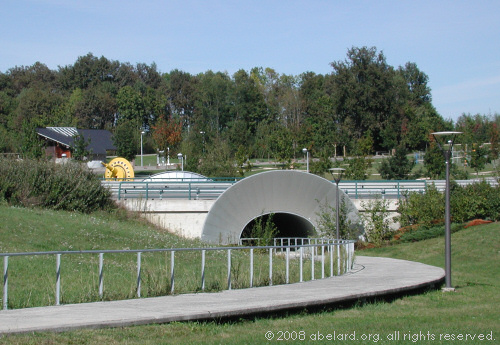
Foot tunnel under the A64 motorway, looking
northwards from the main building
About nineteen
miles east of Tarbes is the gigantic Pic du Midi aire, named after
the nearby 2877 metre peak - Pic du Midi de Bigorre. This aire’s
theme is astronomy and the work of the international observatory
located at the mountain top. On the southern and somewhat
smaller, eastbound site, is the main building, while on the northern,
westbound side of the A64, is the extensive children’s astronomical
play area. There is a pedestrian tunnel, with constellations punched
into the metal cladding, connecting the two parts of this huge
aire. 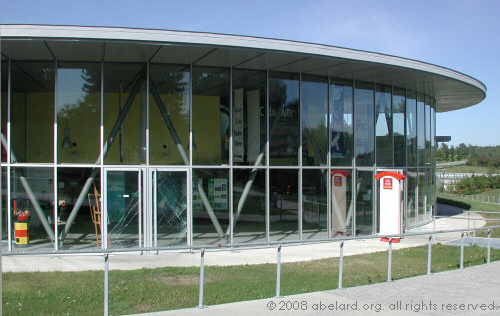
Main building at the Pic du Midi aire with
cafeteria and cinema.
The modern main building houses
a pentascope - a 180° cinema showing on five panels simultaneously
- and a cafeteria. The cafeteria, when visited, appeared rather
uncared for and disheveled. In fact, the whole place was a bit
seedy (you may note the broken door windows in the photo above). The
pentascope screen shows a film made by Productions du Futuroscope
in Poitiers. The film, Passeurs d’étoiles
or Guides to the Stars, retraces the adventurous history
of the Pic du Midi, the construction of the observatory high near
the Pic’s summit, and its research work. When abelard.org
visited, one of the five screens was not working. The 30-minute
film is shown during the day, stopping when the work day of the
person on the information desk stops work [ last showing: 17:30h/5.30pm].
She will answer questions and provides leaflets on visiting the
Pic du Midi Observatory, but her English was somewhat limited.
On the nearby grassland, through the tunnel at the other part
of the aire, are play areas for children, created on astronomical
themes. 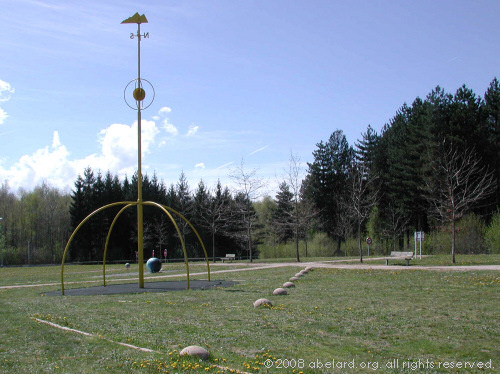
Astronomy-themed play area at Pic du Midi
aire, A64
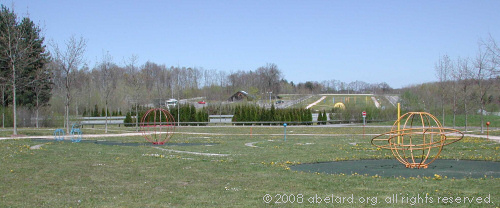

The solar system, including Saturn climbing
frame, Pic du Midi aire, A64
|
advertising disclaimer
|
the
pic du midi observatory
Pic du Midi Observatory - 1937 postcard
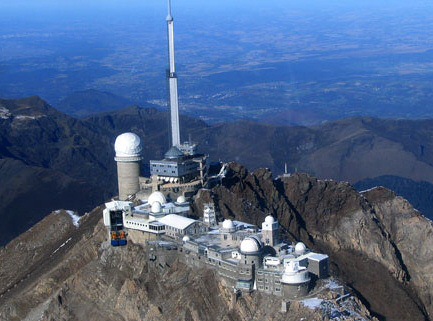
Modern view of the Pic du Midi Observatory.
Source: not known
The
Observatoire du Pic du Midi near Tarbes opened to the
public in July 2000. Visitors take a cable car, travelling
at 12 metres/sec, providing they do not mind riding in “a
bucket on a string”. The trip starts from La
Mongie, at 1,800 metres. Fifteen minutes later, the Observatory
is reached at an altitude of 2,877 metres. Cable cars depart every
15 minutes, the visit taking about two hours. A spectacular panorama
awaits, with its view across the snow-topped Pyrenees, towards
the great plains of southern France and north to the Massif Central
foothills. On clear days, you can make out the lighthouse at Biarritz
(125 miles or 200 km away) and buildings at Barcelona (250 miles
or 400 km away) . Before you visit, it is strongly recommended
that you check the weather, and call the Observatory to verify
that it is open.
| Caution: - Due
to the high altitude, almost 1.8 miles [2.9 km] above than sea
level., there is 30% less oxygen than down at
sea level.
- If you have any respiratory, heart or
other weaknesses, please assess carefully whether a visit would
be safe for your health.
- Note that the site is also not
considered advisable for pregnant women or children under three
years old.
- And don’t forget to bring both warm
clothes and sunglasses.
| The price
of a ticket during the day, including the cable car journeys and
visit to the Observatory is
Adult: 30€, disabled person:
27 €, children between 6 and 12 years: 21€ (under 6
yrs: free)
Family package: 2 adults with 2 children under
18 — 84€, additional child - 21€. The
Pic du Midi is also accessible by hiking trails, but anyone endeavouring
such an expedition must verify for themselves
the routes and their distrance, weather, equipment and personal
fitness - this is not an expedition for the unprepared. For the
few that do reach the summit by foot, there is a special
priced ticket for the return cable car ride. The observatory
is a working scientific site, the sun and its corona
being monitored here daily. As can be seen from the two
photo illustrations above, the site has developed greatly
since early in the 20th century. At the Discovery Centre, visitors
can learn about the research being done with the astronomical
instruments. There is also a restaurant, a snack bar and a
gift shop. The highest museum in Europe housed in the Baillaud
Dome. There are several types
of visits available. As well as extended evening visits watching
the sunset during a meal at the restaurant, all night visits are
possible in order to see the night stars with the naked eye. After
a sleep in a renovated bedroom, visitors can watch the sun rise,
spreading colour onto the (still) snow-covered mountain summits.
This is another way to understand the life of a researcher at
this Observatory. (These night visits are limited to 19 people
a night.)
 |
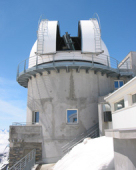
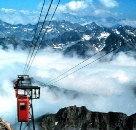
| a
short history of the Pic du Midi Observatory - 1774:
Monge and Darcet studied atmospheric pressure.
- 1873:
General de Nansouty set up a weather station on the Col
de Sencours, below the Pic de Midi.
- 1874:
Road between Bagnères and Barèges built,
passing through through the Col du Tourmalet.
- 1878:
Foundation stone for the Observatory was laid.
- 1888:
Start of international participation in meteorological observations.
- 1908:
8-metre Baillaud Dome built. All material and equipment was brought
up by foot along rough and narrow footpaths.
- 1927:
The Tourmalet-Sencours track opened, enabling equipment to be
brought up during summer by mule.
- 1929:
Project to study the Sun’s corona at times other than eclipses
devised by Bernard Lyot.
- 1931: Coronagraph
built in order to enable systematic observations of the Sun’s
corona.
- 1933: Track extended to the Laquets.
First refuge accommodation built.
- 1940s:
Observation of the Moon’s surface indicates a fine covering
of dust.
- 1949: Steeply sloping track
built to take people and equipment from the Laquets to the summit.
- 1949:
Installation of cosmic radiation detectors.
- 1952:
Cable car built between La Mongie/Taoulet and the Pic
du Midi.
- 1959: 50-cm solar reflector
and turret-dome constructed.
- 1962: Télévision
de France [TDF] building and mast completed.
- 1963:
105-cm telescope constructed for lunar mapping, requested by NASA
for the lunar landings.
- 1980: 2-metre
Bernard Lyot telescope completed.
- 1988 and
beyond: Permanent station for measuring ozone in the atmosphere
added.
- 2000: The Observatory was opened
to the public during the summer season to help promote a culture
of science and technology. There are now about 25,000 visitors
a year.
- 2003: The site is listed as a
site of natural beauty.
Past
directors of the observatory [web site in French]
- Célestin Vaussenat (1882 - 1891)
- Emile Marchand
(1892 - 1914)
- Camille Dauzèze (1920 - 1937)
-
Jules Baillaud (1937 - 1947)
- Jean Rösch (1947 -
1981)
- Jean-Paul Zahn (1981 - 1988)
- Michel Blanc
(1988 - 1998)
- D. Guédalia (1998 -
 the
importance of this observatoryComets, meteors, galaxies
and Milky Way are the heart of the Observatory. The many professional
astronomers come to study the atmosphere, the evolution of the
ozone layer, weather, atmospheric electricity or seismic activity
in the Pyrenees. The history of the site is closely linked to
innovations that gripped astronomy. 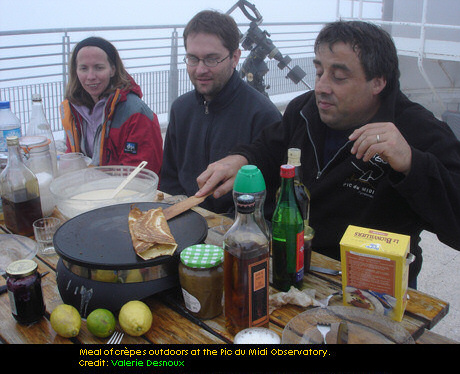 The
Pic du Midi Observatory is at such a high altitude that it is
in the “boundary layer” - the zone of the atmosphere
beyond which the density of air, and the quantity of air molecules,
and air pollution, reduces to none. Thus, the ‘transparency’
of the atmosphere at the height of this observatory enables taking
extremely clear photographs of the moon, sun and other planets. The
Pic du Midi Observatory is at such a high altitude that it is
in the “boundary layer” - the zone of the atmosphere
beyond which the density of air, and the quantity of air molecules,
and air pollution, reduces to none. Thus, the ‘transparency’
of the atmosphere at the height of this observatory enables taking
extremely clear photographs of the moon, sun and other planets.
As well as university and other scientists and researchers from
around the world, this facility is much used by “amateur”
astronomers, who often are semi-professional in their interest.
A medical electronics scientist by profession, Valérie
Desnoux has an impressive web site which includes several
detailed pages on the Pic du Midi and its scientific activities.
On
this page, Valérie Desnoux gives an excellent, personal
account of a working sejourn. It is a detailed description of
one two-week visit, together with many photos of the Observatory
and its inhabitants, the research undertaken and equipment used,
as well as spectacular photos taken of the heavens. In all, it
provides a very good feel of what it is like to live and to work
at this part of the top of the world. 
|
|



| the
telescopes and other instruments[The
links below are to the scientists weblogs’ for each instrument.
The blogs are in French, but copiously illustrated with images
obtained during observation, as well as photos of the observation
rooms, instruments and scientists.]
- The coronagraph [Coro]
records the activity of the sun - the flaring of gases from its
surface - every day of each year. The original chronograph, that
was installed in the Baillaud Dome in 1931, no longer exists.
Instead there is a full-size model in the Baillaud Dome that is
part of the visitors’ tour. Other chronographs were installed
in another dome in 1996-1997.
- Numerous photographs of
the depths of the universe are taken by the Bernard Lyot telescope
[TBL].
At 2 metres diameter, it is the largest telescope in France. It
is housed in a tower 28 metres high, with a 14-metre diameter.
- The
Gentili Dome houses the 60 cm telescope [T60],
which is now used by amateur astronomers interested in spectroscopy.
- Also
in the Gentili Dome is the 1 metre telescope [T1M],
installed with the cooperation of NASA for observing the Moon.
- The
Jean Rösch lens [LJR],
50 cm diameter, is equipped with a spectrograph so the surface
of the sun may be observed. This dome now also includes CALAS
camera, developed for studying solar supergranulation [composed
of gaseous cells about 30,000 km across, that last about 24 hours].

the
pic du midi observatory - some interesting facts
- Snow falls eight months of the year.
- Temperatures
can fall to -30°C during winter nights.
- Water boils
at 92°C, thanks to the lower air pressure.
- There is
30% less oxygen in the air than at sea level.
- Between
five to thirty people work at the observatory. There are people
there every day of the year.
- Floor area, including interior
and connecting corridors: 10,000 square metres.
- Corridors:
5 km.
- Complex is built on six levels.
- Power supplies:
two 12KWA transformers
a
850 KWA generator group - There is a water treatment station.
- 107,795
visitors in 2005.
- Visitor turnover: about 3 million €
a year, now increasing with the inclusion of all-night visits.
- Security:
- • 5 firemen on 24-hour duty
• emergency beds and food for 600 people for 5 days during
the summer/300 people for 10 days during winter
•
a complete pharmacy
• hospital room with decompression
chamber and semi-automatic defibrillator
• direct
link to Haute Pyrénées emergency services (SAMU
and SDIS) - Weather
reports at the Pic du Midi [in French]
- This year,
the Tour de France
cycle race will go over the Col du Tourmalet [alt. 2115m]
on the 14th July - Stage 10.
The Pic du Midi Observatory
is part of the Midi-Pyrenees
Observatory based at Toulouse.

space
Observing
space and the bodies that travel and orbit in it, as well as furthering
its exploration, has long been an interest both of scientists
and military/governmental types in France. France has been
sending missions to space for a decade and more now. The heart
of France’s space industry is at Toulouse, while regions
west are gradually being colonised by industries involved with
or related to space exploration. Created by the City of
Toulouse as a monument to this local industry and as a local attraction
is Space City -
le Cité de l’espace, a theme park specialising
in space and space exploration. The Cité de l’espace
includes a real Mir space station, the predecessor to the International
Space Station.
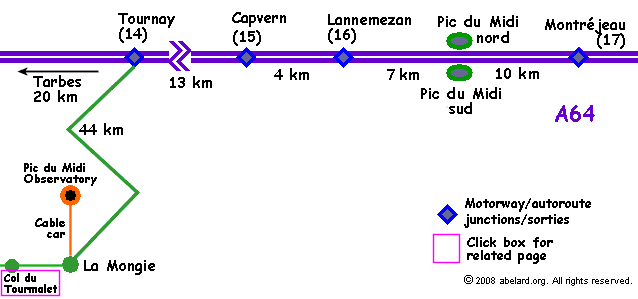
This
aire is accessible from either direction of the A64 motorway.
There is a pedestrian tunnel connecting the two parts of the aire.
You reach the cable car access to the Pic du Midi de Bigorre two
sorties further west at Sortie 14, Tournay. Of course, there are
other routes from the A64 autoroute by which you can reach La
Mongie and the Pic du Midi cable car. This is particularly so
when approaching from the west. However, these alternatives may
well be more awkward to negotiate. Consult your maps and/or online
map services to help with your choice. The Pic du Midi
aire is in Département 65 - Hautes-Pyrénées. See
also the Pyrénées mountain range 
end
notes - aire:
in this context, an area —
aire de loisirs:
recreation area;
aire de pique-nique: picnic area;
aire de repos: rest area;
aire de services:
services , motorway (GB) or freeway (US) service station.
- Col
- A mountain pass between two peaks. A col could also be
a gap in a mountain ridge. The Breech de Roland near Gavarnie
is one such col.
- Pic
- French for
a mountain summit.
- Corona
- Outer, extremely hot, plasma layer of the Sun that sends
out magma eruptions, jets of gas that are visible to the naked
eye during a total solar eclipse.
- For
more information on visiting the Observatory, see www.picdumidi.com
[links to English version of Pic du Midi Observatory web site],
or call 05 62 56 71 11 [English-speaking not guaranteed].
Day
visits
Ticket prices, including cable car ride and visit:
Adult: 30€, disabled person: 27 €, children between
6 and 12 years: 21€ (under 6 yrs: free)
Family package
- 2 adults with 2 children under 18: 84€, additional child:
21€
Audioguide rental (French, Spanish, English, German,
Dutch) : 5 €
1 June to 30 September:
First cable car departure from La Mongie : 9.00 am/09:00
Last cable car departure from La Mongie : 4.30 pm/16:30
Last cable car departure from the Pic du Midi : 7.00 pm/19:00
1 October to 31 May (check
this page for dates open):
First cable
car departure from La Mongie : 10.00 am/10:00
Last cable
car departure from La Mongie : 3.00 pm/15:00
Last cable
car departure from the Pic du Midi : 5.30 pm/17:30
Cable
car trip takes 15 minutes, visit takes about 2 hours.
Evening visits available
on one or more evenings a month [calendar in French]. You
go up to the Observatory during the afternoon, watch the sun set,
have a starlit, and maybe moonlit, meal (a full dinner or fast
food pot-luck depending on the ticket bought, look through various
telescopes and return to La Mongie by 11.30 pm/23:30 hrs. There
are limited numbers of places.
Evening including dinner:
80€ adult, 42€ children under 12.
Evening without
dinner: 50€ adult, 34€ children under 12.
Postal
address: Réservation Soirées, Pic du Midi, Rue Pierre
Lamy de la Chapelle, 65 200 La Mongie, France.
For those that do reach the top by foot, there is a special ticket
to enable taking the cable car back to La Mongie: 20 € for
adult and 10 € for a child under 12.
If you
enter “hotel” and “La Mongie” into this
Pages Jaunes [Yellow Pages] web page, about 40 results come
back, of which the first five are at La Mongie, and the rest are
for a town a bit lower down, Bagnères-de-Bigorre. If you
prefer, you could enter other town names for other hotel details.
Night visits: occur
on one or more nights a month [calendar in French]. As well
as an evening meal, you can visit the scientific facilities and
watch the sunrise. Limited to 19 people per night.
199 €
per person in a single room.
299 € for 2 persons sharing
twin room, (maximum of 8 twin rooms available).
Postal address:
Réservation Nuits, Pic du Midi, Rue Pierre Lamy de la Chapelle,
65 200 La Mongie, France.
Phone reservations: 33
(0)825 00 2877, Office hours, Monday to Friday.
Internet
reservations.
The night car park in La Mongie
is regulated. If you are coming to an evening or a night at the
Pic du Midi, make sure you leave your vehicle on indicated places
[night
cark park map .pdf]. 
|


























